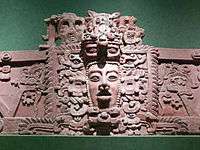Cara Sucia (Mesoamerican site)
 |
| Maya civilization |
|---|
| History |
| Preclassic Maya |
| Classic Maya collapse |
| Spanish conquest of the Maya |
Cara Sucia is a Mesoamerican archaeological site in western El Salvador. The site was first settled in the Preclassic period and was finally abandoned around 900 AD, in the Terminal Classic, when the Pipil people moved into the region, although there is no evidence of Pipil occupation at the site.[1][2] It is thought that during the Early Preclassic (1200–500 BC), the site was occupied by people who spoke a forerunner of the Mayan languages, and during the Late Preclassic period the site has evidence of contact with Chalchuapa and with Kaminaljuyu in the Guatemalan Highlands.[3]
The site is one of the most important archaeological sites in western El Salvador, but has not been restored. It consists of a number of grass-covered mounds, some of which are very large.[1] Archaeologist Paul Amaroli has carried out investigations at the site.[1] Stylistic similarities of the architecture, ceramics and sculpture of the site indicate a link with the Cotzumalhuapa culture in Pacific Guatemala.[1] Cara Sucia is the southeasternmost regional centre associated with this culture.[3][4]
History
Cara Sucia appears to have experienced two principal phases of occupation, the first of which lasted from the Middle Preclassic through to the Late Preclassic and the second from approximately AD 650 to AD 950, in the Late to Terminal Classic period.[5] The principal structures at the site date to the second phase of occupation, during the Late Classic.[6] Late Classic architecture at Cara Sucia includes temples, rectangular houses, two enclosed Mesoamerican ballcourts and a large platform supporting various smaller structures.[3][6] Cara Sucia appears to have been an important site for the manufacture of ceramic figurines and whistles.[3]
Nineteenth-century historian Santiago Ignacio Barbarena first reported the archaeological site with the discovery of various artefacts there, including a stone sculpture of a jaguar head.[3] Cara Sucia has been severely damaged by looters since the Land Reform Programme of 1980, with over 5000 looters' trenches having been recorded.[3] After controls were placed on the import of artefacts to the United States in 1987, the scale of looting was dramatically reduced by the following year.[7] In 1992 Cara Sucia was entered on the UNESCO World Heritage Tentative Lists, together with the El Imposible National Park.[4]
Visiting
The site at Cara Sucia is currently not open for visitors.
Notes
References
- Cobos, Rafael (1998) [1994]. Síntesis de la Arqueología de El Salvador 1850-1991. Colección Antropología e Historia (no.21) (in Spanish). San Salvador, El Salvador: CONCULTURA (Consejo Nacional para la Cultura y el Arte).
- Guthrie Hingston, Ann (2003) [1989]. "U.S. Implementation of the Cultural Property Convention". In Phyllis Mauch Messenger (ed.). The ethics of collecting cultural property: whose culture? whose property? (2nd ed.). ISBN 0-8263-2125-9.
- Kelly, Joyce (1996). An Archaeological Guide to Northern Central America: Belize, Guatemala, Honduras, and El Salvador. Norman: University of Oklahoma Press. ISBN 0-8061-2858-5. OCLC 34658843.
Coordinates: 13°46.612′N 90°02.715′W / 13.776867°N 90.045250°W

